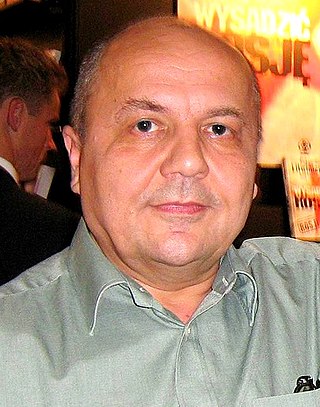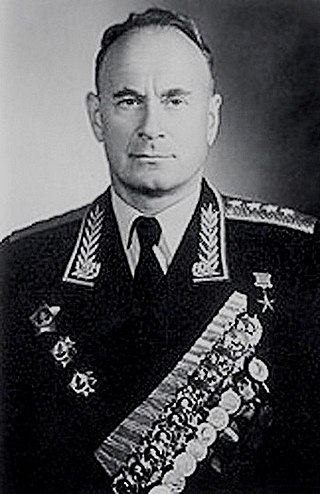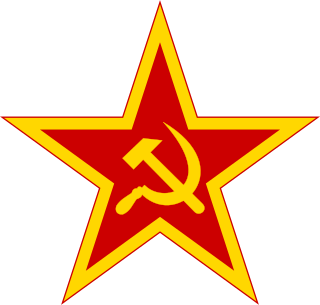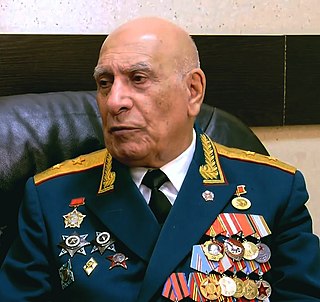Military doctrine is the expression of how military forces contribute to campaigns, major operations, battles, and engagements. A military doctrine outlines what military means should be used, how forces should be structured, where forces should be deployed, and the modes of cooperation between types of forces. "Joint doctrine" refers to the doctrines shared and aligned by multinational forces or joint service operations.

In politics, a defector is a person who gives up allegiance to one state in exchange for allegiance to another, changing sides in a way which is considered illegitimate by the first state. More broadly, defection involves abandoning a person, cause, or doctrine to which one is bound by some tie, as of allegiance or duty.

Dmitriy Fyodorovich Ustinov was a Soviet politician and a Marshal of the Soviet Union during the Cold War. He served as a Central Committee secretary in charge of the Soviet military–industrial complex from 1965 to 1976 and as Minister of Defence of the Soviet Union from 1976 until his death in 1984.

Vladimir Bogdanovich Rezun, known by his pseudonym of Viktor Suvorov is a former Soviet GRU officer who is the author of non-fiction books about World War II, the GRU and the Soviet Army, as well as fictional books about the same and related subjects.

Icebreaker: Who Started the Second World War? is a military history book by the Russian non-fiction author Viktor Suvorov, published in 1988. Suvorov argued that Joseph Stalin planned a conquest of Europe for many years, and was preparing to launch a surprise attack on Nazi Germany at the end of summer of 1941 to begin that plan. He says that Operation Barbarossa was a pre-emptive strike by Adolf Hitler, a claim which the Nazi leader himself had made at the time. Since the 1990s and the dissolution of the Soviet Union, this theory has received some support among historians in some post-Soviet and Central European states, but some Western scholars have criticized his conclusions for lack of evidence and documentation.

Oleg Vladimirovich Penkovsky, codenamed Hero and Yoga was a Soviet military intelligence (GRU) colonel during the late 1950s and early 1960s. Penkovsky informed the United States and the United Kingdom about Soviet military secrets, including the appearance and footprint of Soviet intermediate-range ballistic missile installations and the weakness of the Soviet intercontinental ballistic missile program. This information was decisive in allowing the US to recognize that the Soviets were placing missiles in Cuba before most of them were operational. It also gave US President John F. Kennedy, during the Cuban Missile Crisis that followed, valuable information about Soviet weakness that allowed him to face down Soviet leader Nikita Khrushchev and resolve the crisis without a nuclear war.

The Soviet Air Defence Forces was the air defence branch of the Soviet Armed Forces.

Ivan Alexandrovich Serov was a Soviet intelligence officer who served as Chairman of the KGB from March 1954 to December 1958 and Director of the GRU from December 1958 to February 1963. Serov was NKVD Commissar of the Ukrainian SSR from 1939 to 1941 and Deputy Commissar of the NKVD under Lavrentiy Beria from 1941 to 1954.
The Liberators: My Life in the Soviet Army (1981) by Viktor Suvorov is a non-fiction, personal account of the Soviet Army during the 1960s and 1970s. Drawing from his own experiences, Suvorov provides insight into the brutality of a military machine in which soldiers are treated with little regard. A veteran of the Soviet army and intelligence, Suvorov had defected to the United Kingdom in 1978.

The Soviet Armed Forces, also known as the Armed Forces of the Soviet Union, the Red Army (1918–1946) and the Soviet Army (1946–1991), were the armed forces of the Russian SFSR (1917–1922) and the Soviet Union (1922–1991) from their beginnings in the Russian Civil War of 1917–1923 to the collapse of the USSR in 1991. In May 1992, Russian President Boris Yeltsin issued decrees forming the Russian Armed Forces, which subsumed much of the Soviet Armed Forces. Multiple sections of the former Soviet Armed Forces in the other, smaller Soviet republics gradually came under those republics' control.

Export variants of Soviet military equipment were versions of Soviet military equipment of significantly inferior capability to the original designs and intended only for export. Monkey model was the unofficial designation given by the Soviet Military to such variants. The monkey model was exported with the same or a similar designation as the original Soviet design but in fact it lacked many of the advanced or expensive features of the original.

A space command is a military organization with responsibility for space operations and warfare. A space command is typically a joint organization or organized within a larger military branch and is distinct from a fully independent space force. The world's first space command, the United States' Air Force Space Command was established in 1982 and later became the United States Space Force in 2019.

The Red BannerCarpathian Military District was a military district of the Soviet Armed Forces during the Cold War and subsequently of the Armed Forces of Ukraine during the early Post-Soviet period.

The Ground Forces of the Armed Forces of the Soviet Union was the land warfare service branch of the Soviet Armed Forces from 1946 to 1992. In English it was often referred to as the Soviet Army.

The Soviet offensive plans controversy was a debate among historians in the late 20th and early 21st centuries as to whether Joseph Stalin had planned to launch an attack against Nazi Germany in the summer of 1941. The controversy began with Soviet defector Viktor Suvorov with his 1988 book "Icebreaker: Who started the Second World War?". In it, he claimed that Stalin used Nazi Germany as a proxy to attack Europe.

Norat Grigoryevich Ter-Grigoryants is a retired Soviet and Armenian lieutenant-general who played a leading role in developing the Armed Forces of Armenia in 1992–1995, including during the First Nagorno-Karabakh War.

The M. V. Frunze Military Academy, or in full the Military Order of Lenin and the October Revolution, Red Banner, Order of Suvorov Academy in the name of M. V. Frunze, was a military academy of the Soviet and later the Russian Armed Forces.

Main Intelligence Directorate, abbreviated GRU, was the foreign military intelligence agency of the General Staff of the Soviet Armed Forces until 1991. For a few months it was also the foreign military intelligence agency of the newly established Russian Federation until 7 May 1992 when it was dissolved and the Russian GRU took over its activities.

Colonel General Igor Valentinovich Korobov was the Chief of the Main Directorate of the General Staff of the Armed Forces of the Russian Federation, Russia's military intelligence agency previously known as the GRU.
Yury Aleksandrovich Gorkov was a Soviet and Russian military leader, historian and colonel general. He was a student of professor Viktor Anfilov.
















